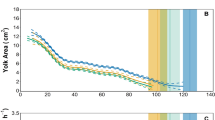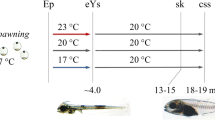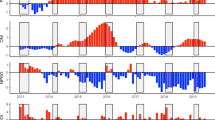Abstract
Early life stages of many marine organisms are being challenged by climate change, but little is known about their capacity to tolerate future ocean conditions. Here we investigated a comprehensive set of biological responses of larvae of two commercially important teleost fishes, Sparus aurata (gilthead seabream) and Argyrosomus regius (meagre), after exposure to future predictions of ocean warming (+4 °C) and acidification (ΔpH = 0.5). The combined effect of warming and hypercapnia elicited a decrease in the hatching success (by 26.4 and 14.3 % for S. aurata and A. regius, respectively) and larval survival (by half) in both species. The length for newly-hatched larvae was not significantly affected, but a significant effect of hypercapnia was found on larval growth. However, while S. aurata growth was reduced (24.8–36.4 % lower), A. regius growth slightly increased (3.2–12.9 % higher) under such condition. Under acidification, larvae of both species spent less time swimming, and displayed reduced attack and capture rates of prey. The impact of warming on these behavioural traits was opposite but less evident. While not studied in A. regius, the incidence of body malformations in S. aurata larvae increased significantly (more than tripled) under warmer and hypercapnic conditions. These morphological impairments and behavioural changes are expected to affect larval performance and recruitment success, and further influence the abundance of fish stocks and the population structure of these commercially important fish species. However, given the pace of ocean climate change, it is important not to forget that species may have the opportunity to acclimate and adapt.





Similar content being viewed by others
References
Ahnelt H, Schade FM, Wegner M (2015) Ocean acidification leads to deformations of caudal vein angio‐architecture in juvenile threespine stickleback, Gasterosteus aculeatus Linnaeus. J. Fish Dis
Anderson JT (1988) A review of size dependent survival during pre-recruit stages of fishes in relation to recruitment. J Northwest Atl Fish Sci 8:55–66
Arias A (1980) Crecimiento, regimen alimentario y reproducción de la dorada (Sparus aurata L.) y del robalo (Dicentrarchus labrax L.) en los esteros de Cadiz. Investig Pesq 44:59–83
Barr DJ, Levy R, Scheepers C, Tily HJ (2013) Random effects structure for confirmatory hypothesis testing: Keep it maximal. J Mem Lang 68:255–278
Baumann H, Talmage SC, Gobler CJ (2012) Reduced early life growth and survival in a fish in direct response to increased carbon dioxide. Nat Clim Chang 2:38–41
Boglione C, Gagliardi F, Scardi M, Cataudella S (2001) Skeletal descriptors and quality assessment in larvae and post-larvae of wild-caught and hatchery-reared gilthead sea bream (Sparus aurata L. 1758). Aquaculture 192:1–22
Bromhead D, Scholey V, Nicol S, Margulies D, Wexler J, Stein M, Hoyle S, Lennert-Cody C, Williamson J, Havenhand J, Ilyina T, Lehodey P (2015) The potential impact of ocean acidification upon eggs and larvae of yellowfin tuna (Thunnus albacares). Deep Sea Res Part II 113:268–279
Collins M, Knutti R, Arblaster J, Dufresne J-L et al (2013) Long-term climate change: projections, commitments and irreversibility. In: Stocker TF, Qin D, Plattner G-K, Tignor M et al (eds) Climate Change 2013: The Physical Science Basis. Cambridge University Press, Cambridge
Dickson A, Millero F (1987) A comparison of the equilibrium constants for the dissociation of carbonic acid in seawater media. Deep Sea Res A 34:1733–1743
Dixson DL, Munday PL, Jones GP (2010) Ocean acidification disrupts the innate ability of fish to detect predator olfactory cues. Ecol Lett 13:68–75
Drost M (1987) Relation between aiming and catch success in larval fish. Can J Fish Aquat Sci 44:304–315
Fernández I, Hontoria F, Ortiz-Delgado JB, Kotzamanis Y, Estévez A, Zambonino-Infante JL, Gisbert E (2008) Larval performance and skeletal deformities in farmed gilthead sea bream (Sparus aurata) fed with graded levels of Vitamin A enriched rotifers (Brachionus plicatilis). Aquaculture 283:10–115
Frommel A, Maneja F, Lowe D, Pascoe C, Geffen A, Folkvord A, Piatkowski U, Clemmensen C (2014) Organ damage in Atlantic herring larvae as a result of ocean acidification. Ecol Appl 24:1131–1143
Harvey BP, Gwynn-Jones D, Moore PJ (2013) Meta-analysis reveals complex marine biological responses to the interactive effects of ocean acidification and warming. Ecol Evol 3:1016–1030
Hurst TP, Fernandez ER, Mathis JT, Miller JA, Stinson CM, Ahgeak EF (2012) Resiliency of juvenile walleye pollock to projected levels of ocean acidification. Aquat Biol 17:247–259
Hurst TP, Fernandez ER, Mathis JT (2013) Effects of ocean acidification on hatch size and larval growth of walleye pollock (Theragra chalcogramma). ICES J Mar Sci 70:812–822
Langenbuch M, Pörtner H (2003) Energy budget if hepatocystes from Antartic fish (Pachycara brachycephalum and Lepidonotothen kempi) as a function of ambient CO2: pH-dependent limitations of cellular protein biosynthesis? J Exp Biol 206:3895–3903
Lewis E, Wallace DWR (1998) CO2SYS-Program developed for the CO2 system calculations. Carbon Dioxide Inf Anal Center, Report ORNL/CDIAC-105
Maneja RH, Frommel AY, Browman HI, Clemmesen C, Geffen AJ, Folkvord A, Piatkowski U, Durif CMF, Bjelland R, Skiftesvik AB (2013a) The swimming kinematics of larval Atlantic cod, Gadus morhua L., are resilient to elevated seawater pCO2. Mar. Biol
Maneja RH, Frommel AY, Geffen AJ, Folkvord A, Piatkowski U, Chang MY, Clemmesen C (2013a) Effects of ocean acidification on the calcification of otoliths of larval Atlantic cod Gadus morhua. Mar Ecol Prog Ser 477:251–258
Mehrbach C, Culberson C, Hawley J, Pytkowicz R (1973) Measurement of the apparent dissociation constants of carbonic acid in seawater at atmospheric pressure. Limnol Oceanogr 18:897–907
Melzner F, Gutowska MA, Langenbuch M, Dupont S, Lucassen M, Thorndyke MC, Bleich M, Portner HO (2009) Physiological basis for high CO2 tolerance in marine ectothermic animals: pre-adaptation through lifestyle and ontogeny? Biogeosciences 6:2313–2331
Munday PL, Dixson DL, McCormick MI, Meekan M, Ferrari MCO, Chivers DP (2010) Replenishment of fish populations is threatened by ocean acidification. Proc Natl Acad Sci U S A 107:12930–12934
Munday PL, Hernaman V, Dixson DL, Thorrold SR (2011) Effect of ocean acidification on otolith development in larvae of a tropical marine fish. Biogeosciences 8:1631–1641
Papandroulakis N, Markakis G, Divanach P, Kentouri M (2000) Feeding requirements of sea bream (Sparus aurata) larvae under intensive rearing conditions: Development of a fuzzy logic controller for feeding. Aquac Eng 21:285–299
Peck M, Huebert K, Llopiz J (2012) Intrinsic and extrinsic factors driving match-mismatch dynamics during the early life history of marine fishes. Adv Ecol Res 47:177–302
Pimentel MS, Faleiro F, Dionísio G, Repolho T, Pousão-Ferreira P, Machado J, Rosa R (2014) Defective skeletogenesis and oversized otoliths in fish early stages in a changing ocean. J Exp Biol 217:2062–2070
Pörtner HO, Peck MA (2010) Climate change effects on fishes and fisheries: towards a cause-and-effect understanding. J Fish Biol 77:1745–1779
Pörtner HO, Langenbuch M, Reipschlager A (2004) Biological impact of elevated ocean CO2 concentrations: Lessons from animal physiology and earth history. J Oceanogr 60:705–718
Pörtner HO, Langenbuch M, Michaelidis B (2005) Synergistic effects of temperature extremes, hypoxia, and increases in CO2 on marine animals: From Earth history to global change. J Geophys Res Oceans 110, C09S10
Pousão-Ferreira P, Castanho S, Ribeiro L, Coutinho J, Bandarra NM, Mendes AC Larval rearing protocols for meagre Agyrosomus regius in LARVI’13 - Fish & shellfish larviculture symposium, Commun. Agric Appl Biol Sci, Laboratory of Aquaculture & Artemia Reference Center, Ghent University, Belgium. pp 378–381
Powell MD, Jones MA, Lijalad M (2009) Effects of skeletal deformities on swimming performance and recovery from exhaustive exercise in triploid Atlantic salmon. Dis Aquat Org 85:59–66
Quéro JC, Vayne JJ (1987) Le maigre, Argyrosomus regius (Asso, 1801) (Pisces, perciformes, sciaenidae) du golfe de Gascogne et des eaux plus septentrionales. Rev Trav Inst Pêches Marit 19(1985):35–66
R Core Team (2014) R: a language and environment for statistical computing. R Foundation for Statistical Computing, Vienna, Austria
Ronnegard L, Shen X, Alam M (2010) hglm: a package for fitting hierarchical generalized linear models. R J 2:20–28
Roo J, Hernández-Cruz CM, Borrero C, Schuchardt D, Fernández-Palacios H (2010) Effect of larval density and feeding sequence on meagre (Argyrosomus regius; Asso, 1801) larval rearing. Aquaculture 302:82–88
Sanatamaría JA, Andrades JA, Herráez P, Fernández-Llebrez P, Becerra J (2005) Perinotochordal connective sheet of gilthead sea bream larvae (Sparus aurata, L.) affected by axial malformations: An histochemical and immunocytochemical study. Dev Biol 240:248–254
Sarazin G, Michard G, Prevot F (1999) A rapid and accurate spectroscopic method for alkalinity measurements in sea water samples. Water Res 33:290–294
Schade FM, Clemmensen C, Wegner KM (2014) Within- and transgenerational effects of ocean acidification on life history of marine three-spined stickleback (Gasterosteus aculeatus). Mar Biol 161:1667–1676
Sfakianakis DG, Koumoundouros G, Divanach P, Kentouri M (2004) Osteological development of the vertebral column and of the fins in Pagellus erythrinus (L. 1758). Temperature effect on the developmental plasticity and morpho-anatomical abnormalities. Aquaculture 232:407–424
Stanley RRE (2009) A biophysical study of connectivity in the early life history of coastal Newfoundland fishes. Memorial University of Newfoundland, St. John’s
Welch MJ, Watson S, Welsh JQ, McCormick MI, Munday PL (2014) Effects of elevated CO2 on fish behaviour undiminished by transgenerational acclimation. Nat Clim Chang Lett 4:1086–1089
Wittmann AC, Pörtner HO (2013) Sensitivities of extant animal taxa to ocean acidification. Nat Clim Chang 3:995–1001
Zuur AF, Ieno EN, Walker N, Saveliev AA, Smith GM (2009) Mixed effects models and extensions in ecology with R. Springer, New York
Acknowledgments
We thank Maresa and CRIPSul for supplying fish eggs, and LusoReef, Oceanário de Lisboa and Aquário Vasco da Gama for supplying rotifers and microalgae.
Author information
Authors and Affiliations
Corresponding author
Ethics declarations
Author contributions
R.R. and M.S.P. designed the experiment; M.S.P. and G.D. performed the experiments; M.S.P., F.F., T.M., R.B., G.D., J.M., P.P.F. and R.R. analysed the data; M.S.P., F.F., T.M., R.B., G.D., A.M.F., J.M., M.P., H.P., E.J.G. and R.R. wrote the main paper. All authors discussed the results and their implications, and commented on the manuscript at all stages.
Funding
The Portuguese Foundation for Science and Technology (FCT) supported this study through doctoral grants to M.S.P. and G.D. (SFRH/BD/81928/2011 and SFRH/BD/73205/2010, respectively), a post-doc grant to F.F. (SFRH/BPD/79038/2011), and project grants to P.P.F. (AQUACOR-PROMAR31-03-05FEP-003) and R.R. (PTDC/MAR/0908066/2008 and PTDC/AAGGLO/3342/2012).
Electronic supplementary material
Below is the link to the electronic supplementary material.
ESM 1
(DOCX 18 kb)
Rights and permissions
About this article
Cite this article
Pimentel, M.S., Faleiro, F., Marques, T. et al. Foraging behaviour, swimming performance and malformations of early stages of commercially important fishes under ocean acidification and warming. Climatic Change 137, 495–509 (2016). https://doi.org/10.1007/s10584-016-1682-5
Received:
Accepted:
Published:
Issue Date:
DOI: https://doi.org/10.1007/s10584-016-1682-5




